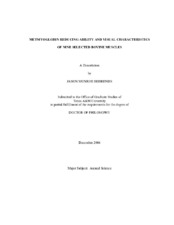| dc.description.abstract | Nine bovine muscles (m. adductor, m. gluteobiceps, m. gluteus medius, m. longissimus lumborum, m. longissimus thoracis, m. psoas major, m. semimembranosus,
m. supraspinatus and m. semitendinosus) were removed from beef carcasses (n = 18) to study the affects of muscle, grade, and display time on color stability. Carcasses represented two USDA quality grades (Choice and Select) equally. Muscles were cut into steaks at 10 d postmortem and displayed under retail conditions for 7 d. Percent fat had a muscle × grade interaction as muscle reacted differently based on grade. The m. gluteobiceps, m. gluteus medius, and m. semitendinosus from Choice carcasses tended to be higher in percent fat than those from Select carcasses. Percent metmyoglobin increased from d 1 to d 7. High color stable muscles (e.g., m. longissimus lumborum and
m. longissimus thoracis) displayed the least percent metmyoglobin. Generally most muscles displayed high metmyoglobin reductase activity throughout retail display. Aerobic reducing ability for low color stability muscles were high on d 1 and decreased dramatically by d 7, whereas high color stability muscles (m. longissimus lumborum and
m. longissimus thoracis) showed an increase in aerobic reducing ability before
decreasing on d 7. Oxygen penetration depth was highest over the retail display in the two most color stable muscles (m. longissimus lumborum and m. longissimus thoracis). Myoglobin content decreased over time for all muscles despite differences in initial myoglobin concentration between muscles. TBARS values generally were a good indicator of discoloration and lean color. Color panel found that low color stability muscles decreased rapidly in lean color and increased in discoloration. Those muscles with poor color stability tended to have lower Hunter L* (lightness) and a* (redness). Muscle clearly had a major impact on overall color stability; however, grade showed only few differences, which conflicted with results from previous research. The USDA Select steaks tended to be higher in color stability than USDA Choice. Data indicated that differences in muscle types and grades play a major role in shelf-stability due to different oxidative potentials and reducing ability, and remain complicated factors in the quest to better understand color stability. | en |


